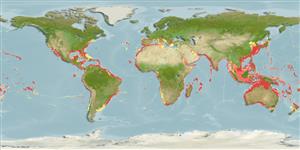Preferred temperature (Ref.
115969): 16.6 - 28.9, mean 27 (based on 3224 cells).
Phylogenetic diversity index (Ref.
82804): PD
50 = 0.5000 [Uniqueness, from 0.5 = low to 2.0 = high].
Bayesian length-weight: a=0.00447 (0.00359 - 0.00555), b=3.09 (3.05 - 3.13), in cm Total Length, based on LWR estimates for this species (Ref.
93245).
Mức dinh dưỡng (Ref.
69278): 4.5 ±0.0 se; based on diet studies.
Thích nghi nhanh (Ref.
120179): thấp, thời gian nhân đôi của chủng quần tối thiểu là 4.5 - 14 năm (rm=0.028; K=0.05-0.09; tm=12-16; tmax=34; Fec=5-12).
Prior r = 0.07, 95% CL = 0.05 - 0.10, Based on 1 full stock assessment.
Fishing Vulnerability (Ref.
59153): Very high vulnerability (87 of 100).
Climate Vulnerability (Ref.
125649): High to very high vulnerability (66 of 100).
